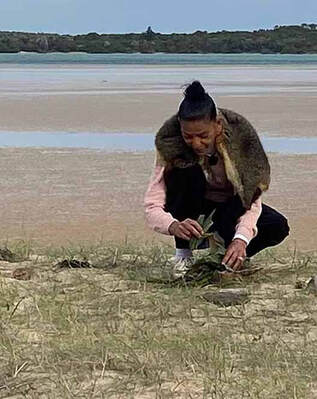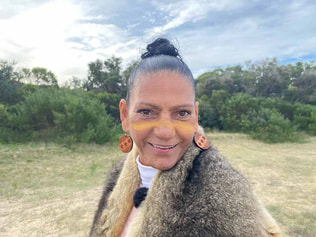 Walk around Inverloch with Aunty Sonia Weston and you see her ancestral links to Country are lived every day. Photos: Laura Brearley
Walk around Inverloch with Aunty Sonia Weston and you see her ancestral links to Country are lived every day. Photos: Laura Brearley THE Cally, about 2006. I’m working as a barmaid. The pub is full of smoke, beer mats need changing and there’s a few precariously perched on their bar stools. A weathered face looks at me conspiratorially, hard rough hands holding the near empty beer. “There’s a few sites, Sall. But farmers don’t want no Aboriginal people on their land. I know there’s a stone circle on a farm in the back hills, but most sites are gone; we’ve moved the rocks to harrow the paddocks.”
This is the story of our district. At high school I was taught this applied to the Bunurong/ Boon Wurrung people too; moved off, destroyed, gone. But while many sites have been destroyed, the Bunurong/ Boon Wurrung are still here and some sites remain and provide a tangible cultural connection to the intangible spiritual and cultural connection to Country.
When you walk from one end of Inverloch to the other, below your feet the shifting sands have covered the stories of Sonia’s ancestors. Among the sites you unwittingly pass are middens (a trove from the discards of feasts, some of the biggest in Victoria), artefacts such as tools and evidence of their creation (such as stone flakes), sand ovens, stone hearths and compressions from where stone or wooden houses once sat. There are individual sites that contain multiple hearths, showing that a large family (or clan group) once lived here for long periods of time, just like they continue to live here today - although the archaeological footprint will look very different. And where there are deep sands, there is always the chance that you are walking upon a burial ground, particularly in large dune systems in our surrounding areas.
Recently, the Bear Gully campsite has been closed. It appears that due to continued human activity in the area, a very sensitive cultural area has been disturbed and exposed. Due to its location it is a significant site to both the Bunurong/ Boon Wurrung and the Gunaikurnai, and so in stabilising the area, both custodians and First People-State Relations (a government appointed organisation that consults on a range of topics, including management of cultural heritage) need to be consulted on how best to protect the site. These are the specialist groups that are required to complete the works under the Aboriginal Heritage Protection Act to ensure traditional owners can return to the sites to fulfil cultural requirements. This practice has been hard won.
 Sonia Weston: "It's not about taking anything away,
Sonia Weston: "It's not about taking anything away,it's about looking after it."
“Who controls the past controls the future; who controls the present controls the past.” George Orwell
| By the 1980s the emergence of more Indigenous rights groups created a shift in the balance of power. In Victoria today, Aboriginal cultural sites are primarily Aboriginal spaces. The Victorian Aboriginal Heritage Act 2006 (VAHA) is the benchmark of heritage protection legislation in Australia and had two primary aims: to resolve existing Native Title claims and to return the control of cultural heritage to traditional owners. To do this it created Registered Aboriginal Parties (RAPs) that represent local traditional owners. The VAHA also created the Victorian Aboriginal Heritage Register and the requirement for all cultural sites to have a Cultural Heritage Management Plan. RAPs must be consulted on the plans for all activities in areas of high cultural sensitivity or in areas where the activity is a high range activity. However, a RAP cannot refuse the activity just because it may harm: “…development takes precedence over the protection of place-based heritage.”* | The 'r' word I am going to slightly digress here, because I have said the ‘r’ word and I want you to stick with me. Culturally racism has been ingrained into us: the white Australia policy did not officially end until 1973. Culture is an inherited trait. When a government had a persistent policy, ideas, philosophies and practices they do not simply end overnight, they also become part of our everyday rhetoric, whether we want them to be there or believe them to be racist. Just like a child inherits the rest of their heritage, they will inherit some of these. I have inherited them. But I can challenge and change these if I am willing to listen to feedback. This is how culture grows and evolves, but we can only improve with a willingness to learn and change. |
Which brings us back to Bear Gully. An article in our local paper was well written and researched but a headline claiming the community had been “outraged” by the park’s closure sparked a torrent of ugly, sometimes racist, expressions of cultural disregard on Facebook.
Aunty Sonia laments, “It sometimes feels like people fear that they are going to lose something. But me, as a custodian, I don't want to take anything away, I want it to be ours, it is our history ... It is not about taking anything away, it is about looking after it. You always have to fight for your culture, I shouldn’t have to fight to simply be an Aboriginal person.”
We live in communities built upon sand and it is in these sandy places that her old people are buried, and there they must remain.
Discovery of human remains
If suspected human remains are discovered, you must contact the Victoria Police and the Coroner's Court of Victoria immediately. If there are reasonable grounds to believe that the remains are Aboriginal, the Coronial Admissions and Enquiries hotline must be contacted on 1300 888 544.
Secret and sacred objects
Legal ownership of secret or sacred objects is held by the Traditional Owners. Anyone who has a secret or sacred object should report it to the Victorian Aboriginal Heritage Council.
Reference
* McGrath, Pamela Faye, (ed) The Right to Protect Sites: Indigenous Heritage Management in the Era of Native Title, AIATSIS Research Publications, 2016, P121